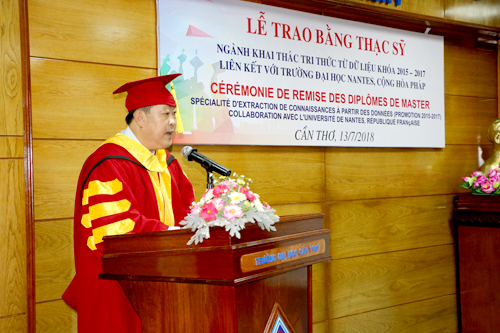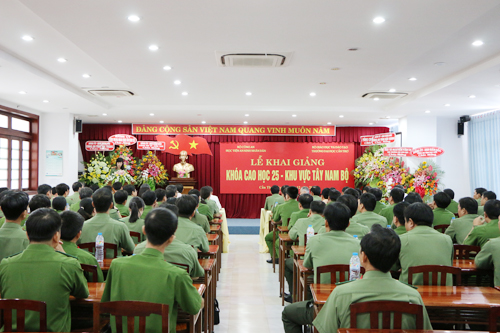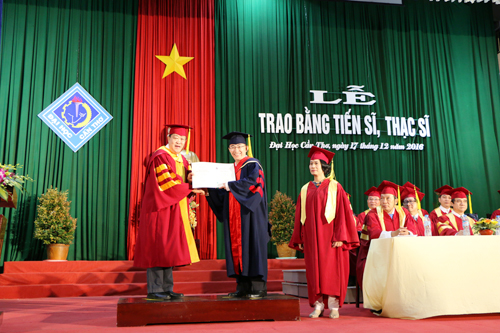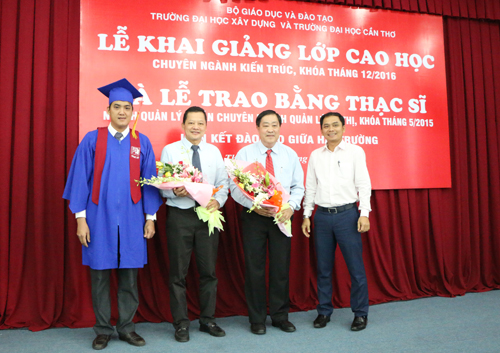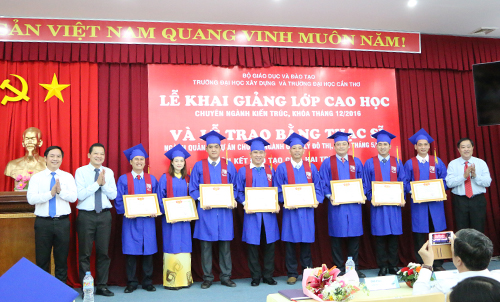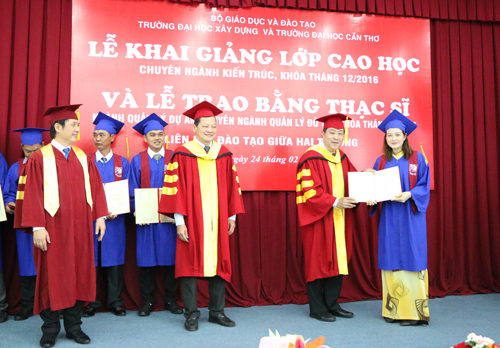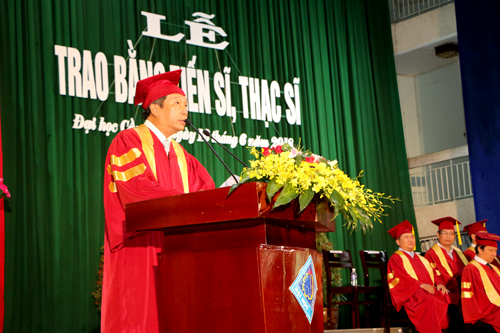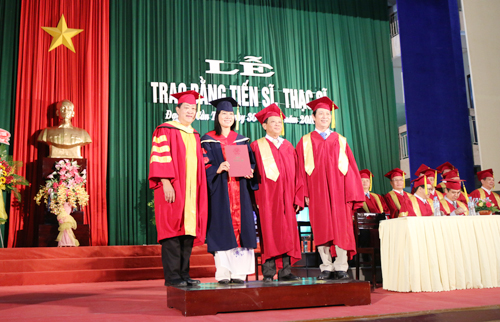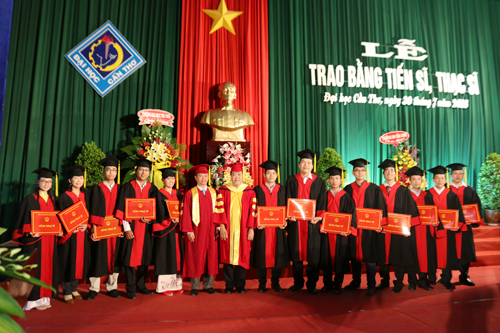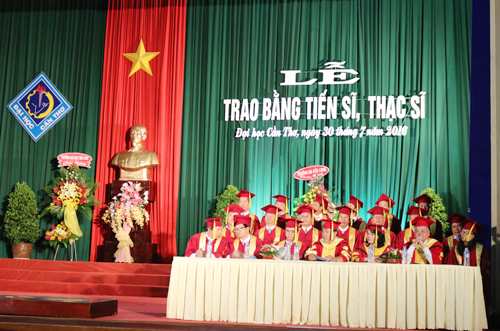
Tên đề tài: “Phân lập, tuyển chọn vi khuẩn sợi (Actinobacteria) từ hải miên vùng biển Hà Tiên và xác định hợp chất sinh học kháng vi sinh vật gây bệnh”.
Tác giả: Trần Vũ Phương, Khóa: 2016
Chuyên ngành: Công nghệ sinh học; Mã số: 62420201. Nhóm ngành: Khoa học sự sống
Người hướng dẫn chính: GS.TS. Cao Ngọc Điệp - Trường Đại học Cần Thơ
Người hướng dẫn phụ: PGS.TS. Ngô Thị Phương Dung - Trường Đại học Kỹ thuật Công nghệ Cần Thơ
- Tóm tắt nội dung luận án
Vi sinh vật gây bệnh kháng kháng sinh ngày nay càng phổ biến và trở thành vấn nạn toàn cầu, do đó, tìm kiếm các nguồn sinh vật có khả năng sản xuất ra các kháng sinh mới là vấn đề cấp thiết. Nhóm vi khuẩn sợi cộng sinh với hải miên tạo ra nhiều sản phẩm thứ cấp ứng dụng trong việc phát triển dược phẩm trị bệnh cho con người. Hải miên có nhiều ở vùng biển Hà Tiên nhưng chưa được nghiên cứu về nhóm vi khuẩn sợi cộng sinh với nó. Nghiên cứu “Phân lập và tuyển chọn vi khuẩn sợi (Actinobacteria) từ hải miên ở vùng biển Hà Tiên và xác định hợp chất sinh học kháng vi khuẩn gây bệnh” được thực hiện nhằm mục tiêu phân lập và tuyển chọn được những dòng vi khuẩn sợi có khả năng sản xuất ra các hợp chất có hoạt tính kháng khuẩn cao, đồng thời xác định được các hợp chất có hoạt tính sinh học, tạo nguồn vật liệu phục vụ cho nghiên cứu sản xuất các hợp chất ứng dụng trong lĩnh vực dược phẩm. Luận án có 5 nội dung nghiên cứu chính bao gồm: (1) Phân lập vi khuẩn sợi từ hải miên ở vùng biển Hà Tiên; (2) Đánh giá và tuyển chọn các dòng vi khuẩn sợi có khả năng kháng với vi sinh vật gây bệnh thử nghiệm gồm Bacillus cereus, Staphylococcus aureus, Salmonella typhimurium, Escherichia coli và Candida albicans, và có khả năng sản xuất hợp chất sinh học có hoạt tính kháng khuẩn cao; (3) Nhận diện và khảo sát mối liên hệ di truyền các dòng vi khuẩn sợi tuyển chọn bằng kỹ thuật sinh học phân tử; (4) Khảo sát sự hiện diện các gen PKS-I, PKS-II và NRPS chỉ thị cho sản xuất các hợp chất có hoạt tính sinh học của các dòng vi khuẩn sợi tuyển chọn; (5) Xác định hợp chất có hoạt tính sinh học của dòng vi khuẩn sợi tiềm năng nhất.
- Những kết quả mới của luận án:
Bộ sưu tập gồm 198 dòng vi khuẩn sợi được phân lập từ hải miên ở vùng biển Hà Tiên, trong đó 130/198 dòng (đạt 65,7%) có khả năng kháng lại ít nhất một trong năm loài vi sinh vật được thử nghiệm gồm Bacillus cereus (82 dòng, đạt 41,4%), Salmonella typhimurium (73 dòng, đạt 36,9%), Candida albicans (42 dòng, đạt 21,2%), Escherichia coli (39 dòng, đạt 19,7%) và Staphylococcus aureus (22 dòng, đạt 11,4%).
Hai mươi ba dòng vi khuẩn sợi đã được tuyển chọn và định danh do có khả năng kháng ít nhất hai dòng vi sinh vật chỉ thị trở lên với mức độ kháng từ trung bình đến kháng mạnh. Các dòng vi khuẩn sợi tuyển chọn thuộc 4 họ bao gồm họ Actinomycetaceae, Microbacteriaceae, Nocardiaceae và Gordoniaceae. Tỷ lệ hiện diện các gen chỉ thị sản xuất các chất có hoạt tính sinh học được ghi nhận có sự khác nhau, bao gồm PKS-I là 69,6%, PKS-II là 60,9% và NRPS là 47,8%.
Hai dòng vi khuẩn sợi tiềm năng nhất có khả năng kháng khuẩn cao đã được định danh là Streptomyces tateyamensis ND1.7a và Microbacterium tumbae ND2.7c. Bảy hợp chất có hoạt tính sinh học được sản xuất từ Streptomyces tateyamensis ND1.7a đã được xác định, gồm có: thymine; 2-pentanone-4-hydroxy-4-methyl; cyclohexasiloxane dodecamethyl; cycloheptasiloxane tetradecamethyl; oxime- methoxy-phenyl; hexanedioic acid bis (2-ethylhexyl) ester và diis
Dissertation title: Isolation and selection of actinobacteria from sponges at Ha Tien Sea and identification of bioactive metabolites against pathogenic bacteria
Major: Biotechnology Major’s code: 62420201
Student’s name: Tran Vu Phuong
Supervisor: Prof. Dr. Cao Ngoc Diep
Assoc. Prof. Dr. Ngo Thi Phuong Dung
Educational institution: Can Tho University
- The summary of the dissertation
Nowadays, antibiotic-resistant pathogens are increasingly popular and addressed as a global problem, therefore, exploration of organisms having the production of new antibiotics is highly considered. Actinobacteria symbiotic with sponges are able to create many secondary products that are applied for the development of pharmaceuticals to treat human diseases. Sponges are abundant in the Ha Tien Sea but they have not been studied on the group of actinobacteria symbiotic with them. The study “Isolation and selection of actinobacteria from sponges at Ha Tien Sea and identification of bioactive metabolites against pathogenic bacteria” was carried out with the aim to isolate and select actinobacterial strains from sponges, which have the ability to produce high antibacterial activity compounds. The five activities were conducted in this dissertation including (1) Isolation of actinobacteria from sponges in Ha Tien Sea; (2) Evaluation and selection of actinobacterial isolates against the tested bacterial pathogens including Bacillus cereus, Staphylococcus aureus, Salmonella typhimurium, Escherichia coli, and Candida albicans, and producing bioactive compounds with high antibacterial activity; (3) Identification and investigation of genetic relationship of selected actinobacteria using molecular biology techniques; (4) Study of the presence of PKS-I, PKS-II, and NRPS genes that indicate the production of bioactive compounds by selected actinobacterial strains; (5) Determination of bioactive compounds of the most potential actinobacteria.
- 2. The innovation outcomes of the dissertation
A total of 198 actinobacterial strains was isolated from sponges, of which 130/198 isolates (65.7%) were resistant to at least one of the five tested bacteria. Based on the results of the antibacterial activity of the actinobacterial isolates, the strength of resistance to the five bacterial pathogens in a range from the strongest to the lowest were found as follows: Bacillus cereus (82 strains, with 41,4%), Salmonella typhimurium (73 strains, with 36,9%), Candida albicans (42 strains, with 21,2%), Escherichia coli (39 strains, with 19,7%), and Staphylococcus aureus (22 strains, with 11,4%).
The twenty-three actinobacterial isolates against at least two of the five tested bacteria with moderate to high resistance were selected and characterized by the genetic sequencing method. They were identified to be belonged to 4 genera: Actinomycetaceae, Microbacteriaceae, Nocardiaceae, and Gordoniaceae. The difference of present rate of genes indicating the production of biologically active substances, including PKS-I, PKS-II, and NRPS, was found as follows: 16/23 strains (with 69,6%), 14/23 strains (with 60,9%), 11/23 strains (with 47,8%); respectively.
The two actinobacterial strains having the highest antibacterial ability, Streptomyces tateyamensis ND1.7a and Microbacterium tumbae ND2.7c, were selected for analysis and identification of biologically active compounds. Seven compounds produced from Streptomyces tateyamensis ND1.7a were found including thymine, 2-pentanone-4-hydroxy-4-methyl, cyclohexasiloxane dodecamethyl, cycloheptasiloxane tetradecamethyl, oxime- methoxy-phenyl, hexanedioic acid bis (2-ethylhexyl) ester, and diisooctyl phthalate. For Microbacterium tumbae ND2.7c, 11 compounds were determined as follows: cyclopentasiloxane decamethyl-, tetrasiloxane 3.5-diethoxy-1,1,1,7,7,7-hexamethyl-3,5-bis(trimethylsiloxy), 1-dodecene, 3-isopropoxy-1,1,1,7,7,7-hexamethyl -3,5,5-tris(trimethylsiloxy) tetrasiloxane, 3,5-di-t-butylphenol, phthalic acid, 3,4-dihydroxymandelic acid 4TMS, 1.6-dioxacyclododecane-7-12-dione, 2-Propyl-1-pentanol, 2-(2’,4’,4’,6’,6’,8’,8’-heptamethyltetrasiloxan-2’yloxy)-2,4,4,6,6,8,8,10,10-nonamethylcyclopentasiloxane, and phthalic acid monoethyl ester. The compounds produced by these two actinobacterial strains were reported by numbers of researchers in the context of their useful biological activities, especially antifungal and antibacterial activities. The results of this study can be used as a basis for further studies, in which to explore the new kinds of medicine produced from symbiotic microorganisms with sponges contributing to protect human health.
- Application feasibility in reality, the problems should be further studied
Application feasibility in reality: The actinobacterial strains with high antibacterial activity isolated from sponges are a source of useful materials that can be used for further research on purification and production of highly biological compounds, contributing to the application of bioactive compounds to treat diseases and protect human health.
The problems should be further studied: The characteristics and biological activities of compounds detected from Streptomyces tateyamensis ND1.7a and Microbacterium tumbae ND2.7c should be further studied, including antibacterial, antiviral, anti-cancer activities, antioxidant, and the safety during the implementation. The factors affecting the production of bioactive substances should be also investigated to determine the optimal culture conditions for the production of biologically active substances from these two selected actinobacteria.
Dooctyl phthalate. Đối với Microbacterium tumbae ND2.7c, 11 hợp chất có hoạt tính sinh học được xác định bao gồm: cyclopentasiloxane decamethyl-, tetrasiloxane 3.5-diethoxy-1,1,1,7,7,7-hexamethyl-3,5-bis(trimethylsiloxy), 1-dodecene, 3-isopropoxy-1,1,1,7,7,7-hexamethyl-3,5,5-tris(trimethylsiloxy) tetrasiloxane, 3,5-di-t-butylphenol, phthalic acid, 3,4-dihydroxymandelic acid 4TMS, 1.6-dioxacyclododecane-7-12-dione, 2-propyl-1-pentanol, 2-(2’,4’,4’,6’,6’,8’,8’-heptamethyltetrasiloxan-2’yloxy)-2,4,4,6,6,8,8,10.10-nonamethylcyclopentasiloxane và phthalic acid monoethyl ester. Kết quả của đề tài về các hợp chất có hoạt tính sinh học hữu ích, đặc biệt là khả năng kháng nấm và kháng khuẩn, là cơ sở khoa học cho các nghiên cứu tiếp theo nhằm tìm ra loại dược phẩm mới sản xuất từ các vi sinh vật cộng sinh với hải miên góp phần bảo vệ sức khỏe cho con người.
- Các khả năng ứng dụng trong thực tiễn, các vấn đề cần tiếp tục nghiên cứu:
Khả năng ứng dụng trong thực tiễn: Các dòng vi khuẩn sợi có hoạt tính kháng khuẩn cao được phân lập từ hải miên là nguồn vật liệu hữu ích có thể sử dụng phục vụ cho nghiên cứu tinh sạch, sản xuất các hợp chất có hoạt tính sinh học cao, góp phần ứng dụng trong nghiên cứu điều trị bệnh và bảo vệ sức khỏe cho con người.
Các vấn đề cần tiếp tục nghiên cứu: Các đặc điểm và hoạt tính sinh học của các hợp chất được xác định từ hai dòng vi khuẩn sợi Streptomyces tateyamensis ND1.7a và Microbacterium tumbae dòng ND2.7c cần được tiếp tục nghiên cứu, như khả năng kháng khuẩn, kháng virus, kháng tế bào ung thư, kháng oxy hóa, và mức độ an toàn khi sử dụng. Các yếu tố ảnh hưởng đến khả năng sản xuất các chất có hoạt tính sinh học cần được thử nghiệm nhằm tìm ra điều kiện nuôi cấy tối ưu ứng dụng trong nghiên cứu sản xuất các hoạt chất sinh học từ hai dòng vi khuẩn sợi này.
- Xem chi tiết nội dung luận án
- Xem thông tin đăng tải tại Website Bộ giáo dục và Đào tạo. (Nhập tên NCS vào ô tìm kiếm)





